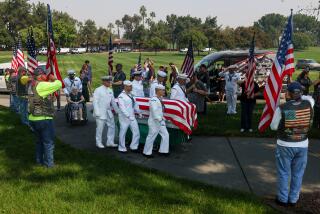House Subcommittee Clears the Navy of Classifying Murders as Suicides : Military: But panel criticizes NIS for failing to follow standard procedure and for poor relations with victims’ families, who dispute report.
- Share via
WASHINGTON — A Navy sailor aboard the Virginia was found strangled at his post, a telephone cord wrapped twice around his neck. His wallet and diary were missing.
The Naval Investigative Service ruled the death of Machinist Mate Kenneth Louthain a suicide, citing testimony that he had exhibited “self-destructive behavior.”
A House subcommittee, in a report released in mid-March, supported that conclusion, but said that in this and seven other military deaths, the Navy sometimes failed to follow standard law enforcement procedure and withheld information from families.
But the House Armed Services Oversight and Investigations subcommittee rejected a more damning charge: that the Navy prefers to avoid controversy by calling murders suicide. The subcommittee found “errors” and “unprofessional actions in individual cases,” but said the Navy “does not have a policy, campaign, conspiracy or predisposition to present homicides as suicides.”
The probe stemmed from complaints by family members who refused to believe official reports that their loved ones committed suicide. The subcommittee focused on eight cases handled by the Naval Investigative Service because most of the complaints concerned Navy or Marine Corps cases.
The conclusion drew an immediate and angry reaction from the family group, “Til We Have Answers,” that formed around the disputed cases.
“This is lip service. I read it twice and I just could not believe it,” said Cathy Jakovic, co-founder of the group. Her son, Scott, was shot and killed in 1991 in what officials said was a game of Russian roulette at a Naval Weapons Station in Earle, N.J. Jakovic said a fellow Marine guard shot her son.
“It’s a lot easier to deal with a suicide than a murder,” Jakovic said.
Although the families criticized the subcommittee report, the finding did confirm their allegations that the Navy sometimes gave conflicting or incomplete reports, failed to return some personal effects, did not follow standard law enforcement procedures such as dusting for fingerprints, and treated family members callously.
In a joint statement, Reps. Norman Sisisky (D-Va.), the subcommittee chairman, and James Hansen of Utah, its senior Republican member, said that although the investigations weren’t bungled, the dealings with family members were.
“The families have emerged from these cases scarred. Many of them feel they were lied to,” Sisisky and Hansen said. “We find they were sometimes patronized and treated as if they were ignorant.”
In seven of the eight cases, the subcommittee found no reason to question the conclusions reached by NIS investigators. The panel said it was “troubled” by an investigation into the February, 1992, death of Marine Lt. Kirk Vanderbur. Vanderbur was found at a rifle range in Hubert, N.C., near Camp Lejeune, dead of a gunshot wound to the head. He was found holding a rifle with his thumb but also had a shotgun wound in the chest. The shotgun was found eight to 10 feet away.
Local police concluded that the death was a suicide. The NIS had a “limited role” in the probe, according to the subcommittee, and reached no conclusion. The subcommittee said the local police finding “does not sit well.”
In other cases, the subcommittee criticized Norfolk base police for letting witnesses leave the scene of a shooting without getting their names and phone numbers. In another case, NIS investigators failed to take fingerprints from a gun linked to what was later termed a suicide and never checked the hands of the victim for powder burns.
And the subcommittee criticized the Marines in a third case for giving a family three different stories about how Lance Cpl. Cornelius Whittles had died in a 1989 shooting, also at the Earle, N.J., naval station. In one version, Whittles was playing Russian roulette. In another, he was cleaning his gun. In a third version, he was playing with his gun. The NIS ruled the case an accidental suicide.
The Navy Cases
Summaries of eight cases investigated by the House Armed Services Oversight and Investigations Subcommittee:
* 2nd Lt. Kirk Vanderbur, Feb. 17, 1992, Hubert, N.C. Vanderbur was shot once in the head and found holding a rifle. He also had a shotgun wound to the chest. The shotgun was found eight to 10 feet away. Local police said Vanderbur failed with the shotgun, possibly by accident, then crawled to the rifle and shot himself. The Naval Investigative Service reached no conclusion. The family disputes the suicide ruling.
* Seaman Mark Dasalla, Dec. 11, 1985, Norfolk, Va., Naval Station. Dasalla grabbed a Marine guard’s pistol in a scuffle and turned on a second guard. The Marine shot Dasalla when he refused to stop. Dasalla’s father, Mark, accused the Navy of “trying to paint my son in a bad light.” The subcommittee said the investigation was sound but criticized base police for failing to get names of eyewitnesses.
* Marine Pfc. James Gardner, Oct. 1, 1991, Naval Submarine Base, Bangor, Wash. Gardner was found dead on the floor of a locked bathroom, a gunshot wound to the head. The handgun was found with the safety in the “on” position. Gardner’s mother, Arlene Ball, said she is willing to accept the suicide ruling but called NIS “arrogant and stupid.” The subcommittee faulted the NIS for failing to take fingerprints or check Gardner’s hands for powder marks.
* Machinist Mate Kenneth Louthain, Oct. 3, 1992, aboard the USS Virginia. Louthain was found dead at his duty station with a telephone cord wrapped around his neck. The body showed no signs of trauma or struggle. NIS ruled the death a suicide, citing testimony that Louthain had exhibited “self-destructive behavior.” The family says Louthain was murdered and accuses the Navy of a coverup. The subcommittee supported the suicide conclusion but criticized the Navy for first telling the Louthains that Louthain was found in the water off Jamaica, later that he was found dead at his duty station, and finally that he was strangled.
* Marine Lance Cpl. Scott Jakovic, Oct. 12, 1991, Naval Weapons Station, Earle, N.J. Jakovic apparently shot himself playing Russian roulette. A fellow Marine who, according to one account, encouraged Jakovic to “do it,” was court-martialed for involuntary manslaughter. The Navy listed the death as an accident. The subcommittee found the investigation “thorough and competent.”
* Marine Cpl. John MacCaskill, May 25, 1988, U.S. Embassy, El Salvador. A State Department investigation ruled that MacCaskill shot himself in the mouth at a San Salvador bar, noting that MacCaskill was drunk and that witnesses reported him despondent. The family wants to question three other Marines who were there. The subcommittee agreed with the suicide finding but criticized the State Department for providing inaccurate information to the family about what happened.
* Marine security officer Michael Leslie, Sept. 19, 1991, Naval Station, Guam. Two local officials heard a gunshot and found Leslie dead with his left wrist handcuffed to the steering wheel and a gun in his right hand. The family suspects murder and wants the case reopened. The subcommittee said the case was well handled.
* Marine Cpl. Cornelius Whittles, April 15, 1989, Naval Weapons Station, Earle, N.J. NIS found that Whittles had been playing with his handgun, including pointing it at his head, when the weapon fired. The subcommittee agreed with the finding but termed the case “a classic example of how not to handle the casualty notification process.” The family was given three different versions of the death: that Whittles was playing Russian roulette, cleaning his gun, or simply playing with the gun.
Source: Associated Press
More to Read
Sign up for Essential California
The most important California stories and recommendations in your inbox every morning.
You may occasionally receive promotional content from the Los Angeles Times.













